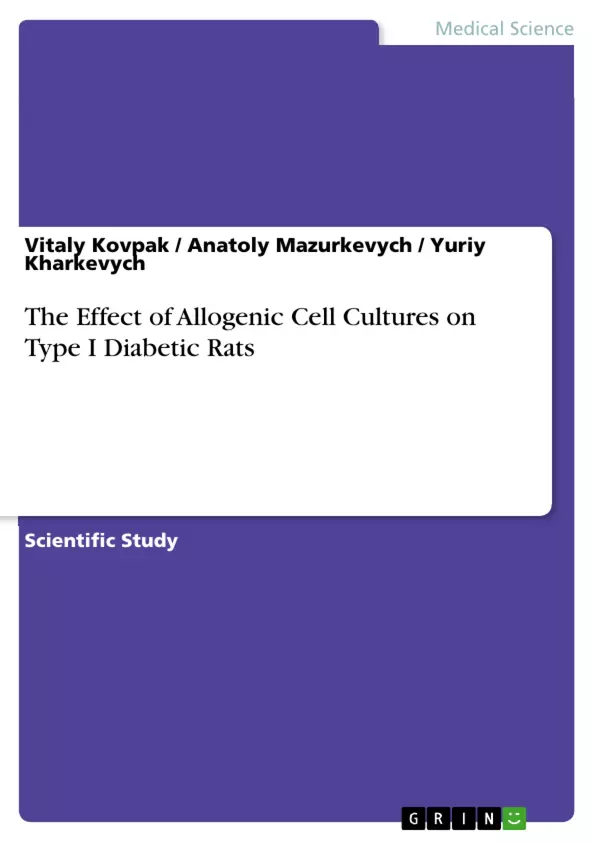This study investigates the changes in the pancreas of rats with the introduction of alloxan, confirming histologically the presence of pathological processes characteristic of type I diabetes. Additionally, a cytogenetic analysis of rat cells in culture obtained from red bone marrow, adipose tissue and pancreas during subcultivation in the in vitro system was performed and their phenotypic characterization was given. Furthermore the histological changes in the pancreas of rats were analysed with the introduction of cell cultures obtained from different sources against experimental diabetes and studied the changes in the blood glucose of experimental animals with the transplantation of cellular material.
Despite the shortcomings of the modern methods of treating animals with type I diabetes using insulin therapy, as well as the fact that pancreatic β-cell death is one of the important elements in the diabetes pathogenesis, new approaches to the treatment of this disease using cell technologies are being studied. Recent studies of β-cells in the in vitro system have shown that they have a fairly high regenerative capacity, but in the in vivo system with diabetes, these cells almost do not recover. The development of methods that can activate β-cell regeneration is an important area of the scientific research.
To date, mainly red bone marrow is used as the source of stem cells for research, because this is the only tissue of the adult body that normally contains immature, undifferentiated and low-differentiated cells. However, adipose tissue is being increasingly used as an alternative source for stem cells, from which they can be isolated in significantly larger quantities using less invasive methods compared to using red bone marrow. It is worth noting that there are still a lot of unclear issues in the study of the pancreas regeneration ways, therefore, in the treatment of patients with diabetes, the direction of the use of cell culture obtained from the pancreas is especially relevant. Given the above, the aim of our study was to study the effect of cell cultures obtained from adipose tissue, bone marrow, and pancreas on the course of experimentally formed insulin-dependent type I diabetes in rats with the aim of developing scientifically based and effective cell therapy methods in veterinary medicine.
Inhaltsverzeichnis (Table of Contents)
- Abstract
- Introduction
- Materials and research methods
- Research results
- CONCLUSION
- BIBLIOGRAPHICAL REFERENCES
Zielsetzung und Themenschwerpunkte (Objectives and Key Themes)
The primary objective of this study was to investigate the effect of cell cultures obtained from bone marrow, adipose tissue, and pancreas on the progression of experimentally induced type I diabetes in rats. The research aimed to develop effective and scientifically-based cell therapy methods for treating diabetes in veterinary medicine.
- Comparative analysis of cell cultures from different sources (bone marrow, adipose tissue, and pancreas)
- Evaluation of the impact of cell transplantation on the course of experimental diabetes in rats
- Investigation of the regenerative potential of stem cells in relation to pancreatic islet tissue
- Assessment of the effectiveness of cell therapy approaches for treating diabetes
- Exploration of the potential of adipose tissue as an alternative source of stem cells for therapeutic purposes
Zusammenfassung der Kapitel (Chapter Summaries)
- Abstract: The abstract outlines the study's motivation, focusing on the limitations of traditional insulin therapy for diabetes and the potential of cell-based approaches for regeneration of pancreatic β-cells. The study's aim is to evaluate the effectiveness of cell cultures from various sources in treating experimentally induced type I diabetes in rats.
- Introduction: The introduction provides background information on the challenges associated with treating diabetes, emphasizing the role of pancreatic β-cell death in disease pathogenesis. It highlights the increasing interest in cell therapy approaches, particularly using stem cells derived from bone marrow and adipose tissue, as potential solutions for diabetes management. The study aims to investigate the effectiveness of cell cultures derived from these sources, along with pancreatic tissue, for treating type I diabetes.
- Materials and research methods: This chapter details the materials and methodologies employed in the study. It includes information on the animal models used, the methods for generating experimental diabetes, the techniques for obtaining and culturing stem cells, and the assessments performed to analyze the effects of cell transplantation.
- Research results: The research results section presents the findings of the study. It discusses the characterization of cell cultures, including their morphological and phenotypic properties, as well as cytogenetic analyses. It also analyzes the impact of cell transplantation on blood glucose levels, pancreatic morphology, and islet tissue regeneration.
Schlüsselwörter (Keywords)
This study focuses on the application of cell therapy, utilizing stem cells derived from bone marrow, adipose tissue, and pancreas, to address type I diabetes in a rat model. The research explores the potential of these cell sources for regenerating pancreatic β-cells and improving glycemic control in diabetic animals. Key terms include: type I diabetes, cell therapy, stem cells, bone marrow, adipose tissue, pancreas, pancreatic islet regeneration, Langerhans islets, blood glucose levels, cytogenetic analysis, phenotypic characterization, and regenerative medicine.
- Quote paper
- Vitaly Kovpak (Author), Anatoly Mazurkevych (Author), Yuriy Kharkevych (Author), 2020, The Effect of Allogenic Cell Cultures on Type I Diabetic Rats, Munich, GRIN Verlag, https://www.grin.com/document/915037



